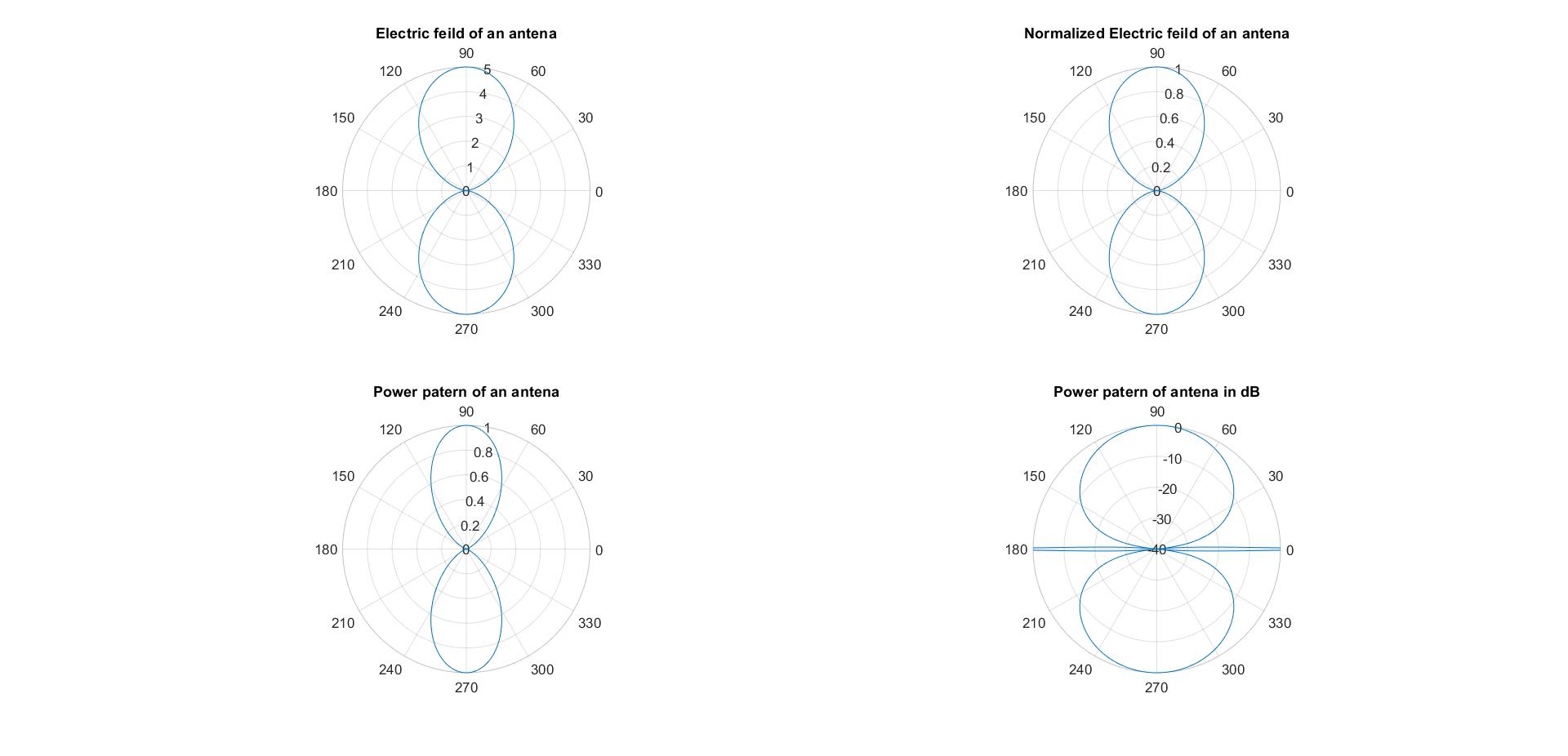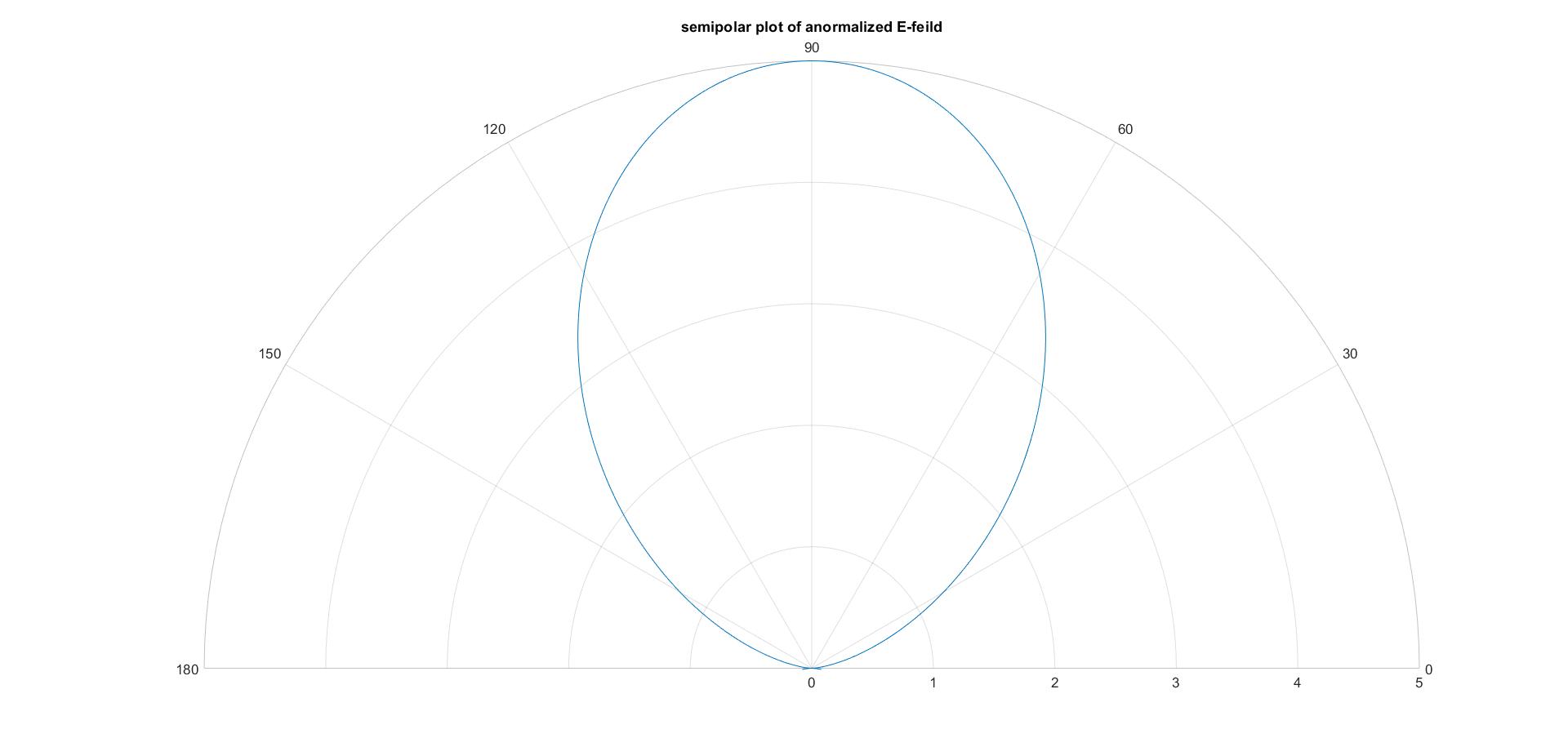Introduction
Two Dimensional(2-D) Polar and Semi-Polar Patters using Matlab code.
Two-dimensional (2-D) polar and semi-polar patterns are graphical representations of the radiated power density in a plane perpendicular to the axis of an antenna. Polar patterns show the radiation in all directions around the antenna axis, while semi-polar patterns show the radiation in only half of the space around the antenna axis.
In a polar pattern, the radial axis represents the gain of the antenna in a particular direction, while the angular axis represents the angle relative to the antenna axis. The shape of the polar pattern is a representation of the directivity and beamwidth of the antenna.
Semi-polar patterns are similar to polar patterns but show only one half of the space around the antenna axis. This can be useful for analyzing the front-to-back ratio, sidelobe levels, and beamwidth of the antenna.
The 2-D polar and semi-polar patterns are typically obtained through experimental measurement or simulation, and can provide valuable information about the radiation characteristics of an antenna. They can be used to optimize the performance of an antenna, such as increasing the directivity, reducing sidelobe levels, or improving the beamwidth.

Lobes
A radiation pattern lobe is a portion of the overall radiation pattern of an antenna that represents the radiated power density in a particular direction. Lobe refers to a peak or maximum in the radiation pattern, which represents the main direction of radiation. The main lobe, also known as the major lobe, is the lobe that contains the highest level of radiated power.
In a typical antenna radiation pattern, there are several lobes, including the main lobe and the side lobes. The side lobes are the secondary maxima in the radiation pattern, and they represent the power radiated in directions other than the main lobe. The side lobes can be further classified into sidelobes, backlobes, and secondary lobes, depending on their location relative to the main lobe.
The amplitude of the side lobes, relative to the main lobe, is an important factor in determining the directivity and beamwidth of an antenna. Antennas with lower sidelobe levels have a narrower beamwidth and higher directivity. On the other hand, antennas with higher sidelobe levels have a wider beamwidth and lower directivity.
In summary, the radiation pattern lobe is a fundamental concept in the analysis and design of antennas, and provides important information about the directionality and radiation characteristics of the antenna.
Software Required
Matlab Software or online matlab.
Procedure
- Define the array parameters: Define the number of elements, inter-element spacing, and complex weights for each element.
- Compute the array factor: Use the Array Factor equation to calculate the array factor for a range of angles in two dimensions (azimuth and elevation).
- Plot the polar or semi-polar pattern: Plot the magnitude of the array factor in polar or semi-polar coordinates to obtain the 2-D polar or semi-polar pattern of the array.
Algorithm
➢ Start
➢ Assign the theta level and step size
➢ F=sin(theta).*cos(theta)
➢ Polar and field pattern
➢ F_norm =f/max(f)
➢ Polar plot of normalized field pattern
➢ P=f^2
➢ P_norm=p/max(p)
➢ Polar plot of the normalized power pattern
➢ Power in dbs
➢ P_db=10log10(P_norm)
➢ Polar plot power pattern in dB
➢ Set the rlimits
➢ rlim([-30 0])
➢ polar plot of the normalized semipolar field pattern stop
Matlab Code
clear all;
close all;
clc;
theta = -pi:0.01:pi; % creation of a angle vector
f = 5*sin(theta).*sin(theta);% electric feild Vector
f_norm = f/max(f);% Normalization (normalized electric feild vector)
power = f_norm.^2;% Power feild
Power_in_db = 10*log10(power);%power in dB
figure(1),
subplot(221)
polarplot(theta,f);
title('Electric feild of an antena');
subplot(222)
polarplot(theta,f_norm);
title('Normalized Electric feild of an antena');
subplot(223)
polarplot(theta,power);
title('Power patern of an antena');
subplot(224)
polarplot(theta,Power_in_db);
rlim([-40,0]);
title('Power patern of antena in dB');
figure(2),polarplot(theta,f);
thetalim([0,180]);
title('semipolar plot of anormalized E-feild');Code Output


Conclusion
In conclusion, the 2-D polar and semi-polar patterns are important representations of the radiation characteristics of an antenna. They provide information about the distribution of radiated power in different directions, and can be used to evaluate the directivity, gain, and beamwidth of an antenna.
The 2-D polar pattern is a full representation of the radiated power in all directions, while the 2-D semi-polar pattern only represents the radiated power in one plane. The 2-D polar and semi-polar patterns can be computed using mathematical models and numerical methods, such as the Array Factor equation, and can be plotted in polar or semi-polar coordinates.
The magnitude of the array factor is used as a measure of the radiated power, and is plotted in the 2-D polar or semi-polar pattern to obtain the final representation of the radiation characteristics of the antenna. The computation and analysis of 2-D polar and semi-polar patterns are essential steps in the design and optimization of antennas for various applications.
Explore More Projects on Matlab
- Microwave and Antenna Various Matlab CodesMicrowave and Antenna Various Matlab Codes. Some of the Projects are below. Polar form for a Symmetrical Dipole of Finite… Read more: Microwave and Antenna Various Matlab Codes
- Multiple Input Multiple Output(MIMO) using MatlabIntroduction Multiple Input Multiple Output(MIMO) using Matlab. Multiple Input Multiple Output (MIMO) is a technology used in wireless communication systems… Read more: Multiple Input Multiple Output(MIMO) using Matlab
- Pulse Width Modulation(PWM) working Principal using MatlabIntroduction Pulse Width Modulation(PWM) working Principal using Matlab. PWM stands for Pulse Width Modulation. It is a type of digital… Read more: Pulse Width Modulation(PWM) working Principal using Matlab
- Quadrature Amplitude Modulation(QAM): Theory and MatlabIntroduction Quadrature Amplitude Modulation(QAM): Theory and Matlab QAM stands for Quadrature Amplitude Modulation. It is a method of combining two… Read more: Quadrature Amplitude Modulation(QAM): Theory and Matlab
- Polar form for a Symmetrical Dipole of Finite Length: Matlab ScriptPolar form for a Symmetrical Dipole of Finite Length: Matlab Script. This Experiment include finding of: Introduction The polar form… Read more: Polar form for a Symmetrical Dipole of Finite Length: Matlab Script
- Radiated Power and Maximum Directivity of any Antenna: Theory and Matlab codeRadiated Power and Maximum Directivity of any Antenna: Theory and Matlab code. Introduction The radiated power of an antenna refers… Read more: Radiated Power and Maximum Directivity of any Antenna: Theory and Matlab code
- Polar form for a Loop Antenna with Uniform Current: Theory and Matlab codeIntroduction The polar form for a loop antenna with uniform current can be determined using the far-field approximation and the… Read more: Polar form for a Loop Antenna with Uniform Current: Theory and Matlab code
- Two Dimensional(2-D) Polar and Semi-Polar Patters using Matlab codeIntroduction Two Dimensional(2-D) Polar and Semi-Polar Patters using Matlab code. Two-dimensional (2-D) polar and semi-polar patterns are graphical representations of… Read more: Two Dimensional(2-D) Polar and Semi-Polar Patters using Matlab code
Join us for Regular Updates
| Telegram | Join Now |
| Join Now | |
| Join Now | |
| Join Now | |
| Join Now | |
| Join our Telegram | connectkreations |
About Connect Kreations
We the team Connect Kreations have started a Blog page which is eminently beneficial to all the students those who are seeking jobs and are eager to develop themselves in a related area. As the world is quick on uptake, our website also focuses on latest trends in recent technologies and project learning and solutions. We are continuously putting our efforts to provide you with accurate, best quality, and genuine information. Here we also have complete set of details on how to prepare aptitude, interview and more of such placement/ off campus placement preparation.
Connect Kreations is excited to announce the expansion of our services into the realm of content creation! We are now offering a wide range of creative writing services, including poetry, articles, and stories.
Whether you need a heartfelt poem for a special occasion, a thought-provoking article for your blog or website, or an engaging story to captivate your audience, our team of talented writers is here to help. We have a passion for language and a commitment to creating high-quality content that is both original and engaging.
Our services are perfect for individuals, businesses, and organizations looking to add a touch of creativity and personality to their content. We are confident that our unique perspectives and diverse backgrounds will bring a fresh and exciting voice to your project.
Thank you for choosing Connect Kreations for your content creation needs. We look forward to working with you and helping you to bring your vision to life!
The website is open to all and we want all of you to make the best use of this opportunity and get benefit from it..🤓
- Our Websites: Connect Kreations
- Our Websites: StudentsDev Connect Kreations





